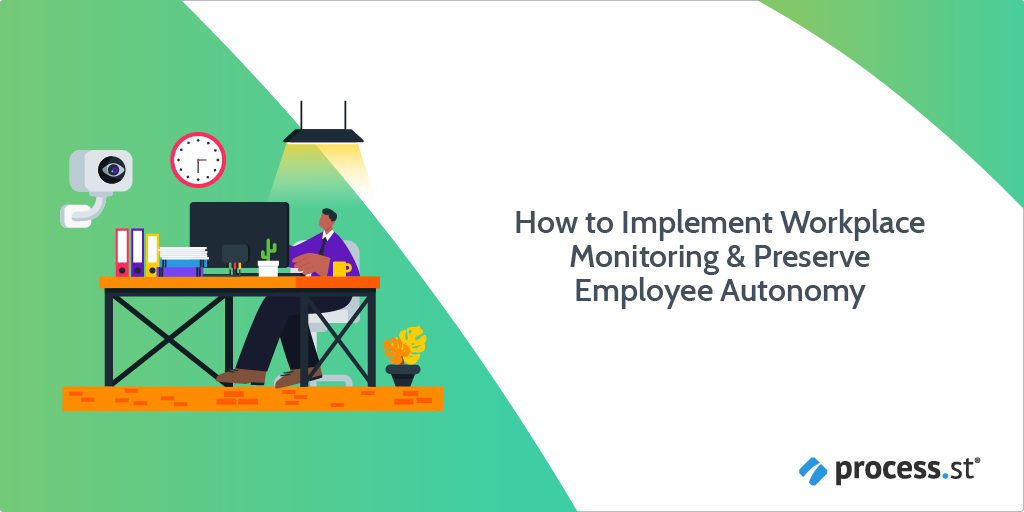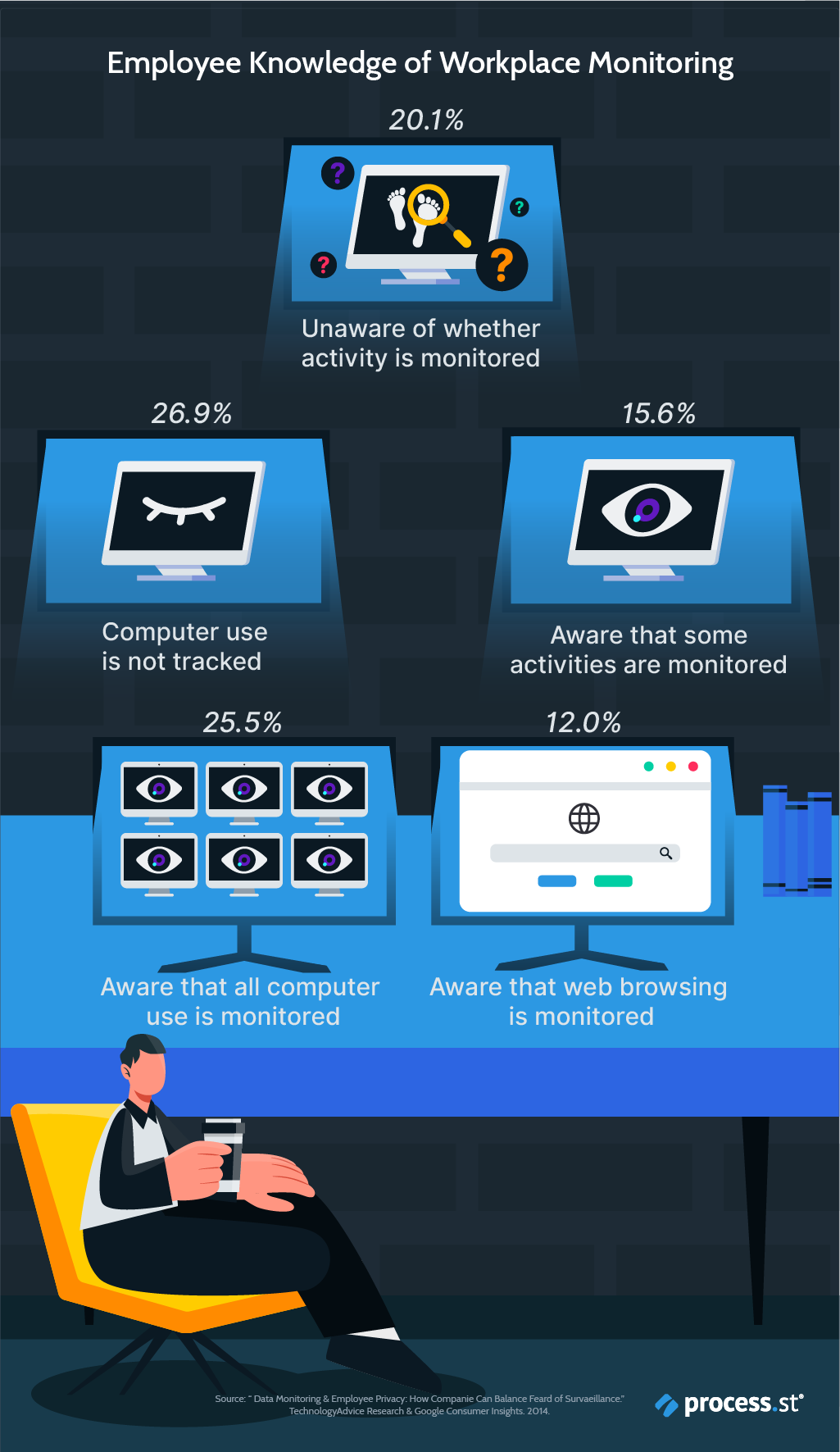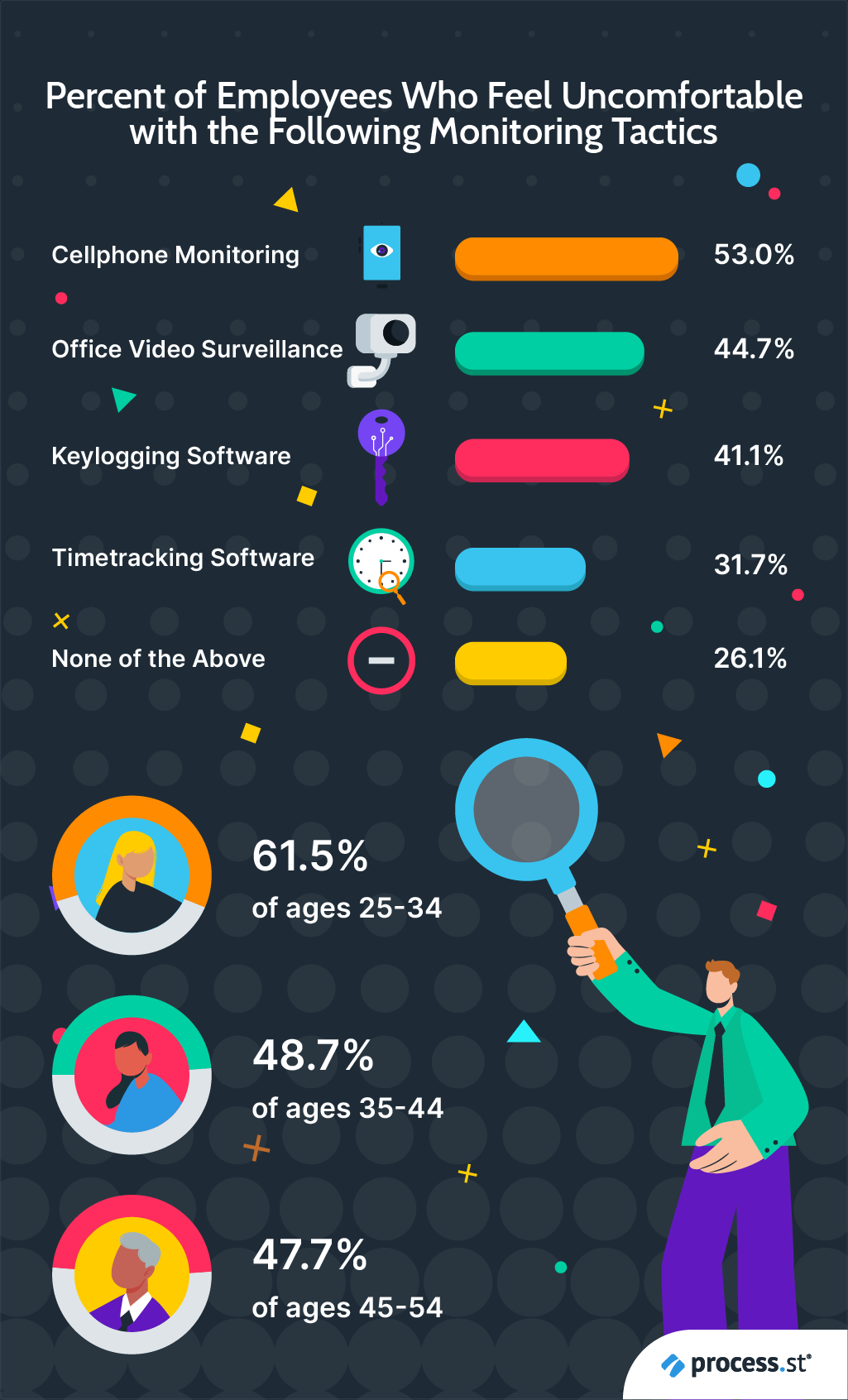 I play video games at work.
I play video games at work.
It’s the remote manager’s nightmare: A wayward employee who does whatever they want because they lack the strict supervision of the office to keep them in line. Critics of remote work would seize on this very scenario as proof that remote workers are merely lazy and entitled.
Should employees’ web activity be tracked to make sure they’re putting in a solid eight hours of work time?
For those remote workers who don’t have designated space or equipment that is “work use only,” why should they agree to be surveilled in their homes and on their personal devices?
How do you guarantee that both your clients and your employees can feel secure that what is meant to be private will not be made public?
Most importantly, if the deliverables are delivered when they should be, does it matter how they got there?
In this Process Street post, I’m going to (attempt) to provide answers to some of those questions, discuss the issues employers need to consider before monitoring employees, and look at some “soft surveillance” alternatives to hard data collection.
- The case for workplace monitoring
- In defense of employee autonomy
- Creating a sustainable balance between monitoring & autonomy
The case for workplace monitoring
A lot of weight gets put on the implication that employees are all huge lying liars who won’t do any work if you don’t scrutinize their every move. Granted, that is one motivation for employee monitoring, but it’s not the only motivation.
So as to not contribute any more to the “us versus them” mentality, I want to go over the beneficial side of employee monitoring in terms of workplace security.
Workplace monitoring to enhance data security
Every organization has some sort of sensitive data stored in a database. Depending on what the organization does, this can vary from simple names and addresses to personal details to intellectual property.
Regardless of whether this information belongs to clients, employees, or both, it obviously needs to be safeguarded.
For example, at Process Street we use a lightweight monitoring system to verify we have certain security settings in place and that those settings are working properly. This allows us to keep our customers’ data safe while also being non-invasive when it comes to employees’ personal devices.
Another fairly lightweight solution is the use of a VPN to access specific files or data that need to be kept secure. Universities often require staff and students to log in via a VPN in order to access student details, grades, or other protected information when off-campus.
Monitoring productivity trends
No, employee monitoring alone can’t – and won’t – increase employee productivity. In fact, if you don’t approach it properly, you can hurt not only your employees’ productivity but their morale, trust, and overall job satisfaction.
Employee monitoring can help you identify where the productivity gaps and bottlenecks are happening.
We use Process Street workflows for this. I mean, it makes the most sense, right?
Under the reports tab in the Process Street dashboard, we can make saved views for different workflows, tasks, users, and statuses.
Let’s say our editor wants to know how we’re each doing on our respective blog posts. He can go straight to a saved view for our blog post production workflow and see every active workflow, who it’s assigned to, and how much has been completed.
It turns out that a peer review for an upcoming post hasn’t been completed yet. Our editor can then go into the workflow, see the person assigned to that task, and talk to them about what’s going on.
The peer review could be held up for any number of reasons, but by monitoring the progress of our workflows, our editor can stay on top of which tasks and/or employees need extra attention and support.
Increased transparency between teams and leadership
The saved views feature comes into play here as well.
So, just like our editor can look at each of our workflows, the members of the content team are able to view all of the blog post workflows as well.
Let’s say I’m supposed to do the peer review, but the writer hasn’t sent it to me yet. I can go into that workflow and see how far along they are in terms of writing the post and approximately when I can expect the post to be ready for review.
Alternatively, say the writer is having a problem with one of the tasks. Maybe the keyword research isn’t going well or there could even be a glitch in the workflow. The writer can share that workflow with the rest of the team and ask for feedback or advice.
By using these workflows to document our processes, it maintains accountability and clarity so everyone knows what work has been done, what needs to be done, and who is expected to do it.
Workplace monitoring as an alternative to direct supervision
A lot of people probably think of employee monitoring as a form of micromanaging itself, but it can actually be used to give employees more freedom.
If a manager or supervisor is able to look at a report and determine if a project or task is on track, they don’t have to check in with their employees every time they want a status update. This allows supervisors to stay in the loop on any progress without interrupting or distracting employees from what they’re doing.
It also means that supervisors can check progress when they need to rather than messaging the employee and waiting for a response (which, in asynchronous environments, could be a day or more).
This scenario is really a win-win. The employees don’t feel like they have to explain every decision or action they take, but the supervisor still knows exactly what’s happening with the project. And, if there does happen to be a problem, the supervisor already has the information necessary to act without having to be briefed first.
Collect & analyze performance insights
It’d be tempting to say that performance insights will show you where things are going wrong, but performance insights can offer so much more than simply identifying problems.
Monitoring performance insights can also tell you when your people are at their best. Maybe two or three employees perform higher when they’re assigned to the same project as opposed to when they work with other colleagues. Maybe your Germany-based CSM is most productive late at night so they coordinate better with US-based customers. Maybe you have an employee in Canada who needs to collaborate with someone in New Zealand and they need help coordinating their schedules to be most effective.
All of these things can be figured out using performance insights, and none of them involve any negative or disciplinary action. Each instance is about enabling your employees to do their best work in the way that works best for them (and your business).
In defense of employee privacy & autonomy
Now that we’ve gone over all the good parts, let’s look at the things your employees will be worrying about.
 The thing you need to really consider when it comes to workplace monitoring is: How informed are your employees about what is monitored and why?
The thing you need to really consider when it comes to workplace monitoring is: How informed are your employees about what is monitored and why?
If only 25% of your employees are aware that their computer use is monitored by your organization, you’re going to have a problem when the other 75% find out. And they will find out. Employees are human, after all, and there are typically very few secrets among humans that spend large amounts of time together. You can implement all the policies you want, but I guarantee your employees are more informed about your organization than you think they are.
There is really no reason to secretly monitor your employees in the workplace. Obviously, there will be certain instances when an employee doesn’t know they’re being monitored at a specific moment – during a call center quality assurance audit, for example – but that employee should still be aware that monitoring takes place, how it’s conducted, and what it’s used for.
Just you, me, and the team Slack channel
Privacy is a big one. I’ll go over the legal and ethical aspects further on, but – essentially – people get really uncomfortable with being watched.
And yeah, I know. We’re surveilled everywhere we go, digitally or physically. There’s a difference, though, between Google knowing you can never remember the difference between “i.e.” and “e.g.” and all of upper management learning the details of a private health issue when you thought you were having a confidential conversation with your line manager.
Maintaining a sense of privacy for employees is important, but especially so for remote employees.
Employees need to feel secure that they can have confidential discussions with colleagues. Some of those discussions will be about serious issues and wellbeing, but your employees will have frustrations and they need to be able to discuss them with their coworkers.
Work is not just about work, after all. Sometimes you just really need to say that your boss sucks and have a colleague go, “Yeah, what is up with that guy today?”
Sure, you can say that it’s unprofessional. They should only have those conversations on their own time. You shouldn’t write down anything you don’t mean. On and on ad nauseam.
So let’s talk logistics. All of my devices are synced to my work apps. Phone, computer, iPad – everything. If I have to use my phone to jump into a Zoom meeting because my computer spontaneously overheats (true story), I should be able to do that without worrying that my personal messages will be rifled through solely because they were tangentially associated with work product for a brief period of time.
If you’ve got nothing to hide, then what are you worried about?
Concerns about employee privacy aren’t solely about whether or not your employees trust you. What and how you monitor your employees also shows them whether or not you trust them.
Way, way back, I worked the graveyard shift at what the owner called an “urban market” (think Whole Foods, if it were a gas station). It was not great, for a variety of reasons that generally surfaced when the bars and clubs closed at 2 AM, but there was another reason.
The owner had CCTV set up inside and out. Fine. Plenty of businesses have it for security, safety, and all those good things. He could watch the live feed from his house, too, which is not how I’d spend my evenings but to each their own.
He was one of those people who believes busyness is the same as productivity. Even if there were literally no other tasks to do, you had to find something to do. If you didn’t, he would call the store and scold you for it.
Plot twist: It did not make us work harder.
If anything, we worked slower because we knew we had to take up that eight hours with tasks – regardless of whether or not those tasks were useful, necessary, or productive.
It also told us, in no uncertain terms, that he didn’t trust us to do our jobs.
Mishandling your approach to employee monitoring can irrevocably damage the trust between you and your employees. After all, if you don’t trust your employees, why should they trust you? Why should they have any loyalty to your company? Why did you even hire them in the first place? Why should they stay with an organization that thinks they’re dishonest?
And they would be absolutely right in thinking those things.
Always check the fine print
Laws and regulations around data privacy, collection, and storage vary from region to region. Any monitoring of your employees needs to follow the guidelines of wherever your company is located, but also the area the employee is located in.
With remote workers who can literally be anywhere in the world at any given time, this complicates things.
Let’s talk about the GDPR – the European Union’s (EU) General Data Protection Regulation.
Your company is based in the US. All of your customers and employees are in the US. What does the GDPR have to do with you?
Well, potentially a lot. See, the GDPR isn’t only about customer data, and it isn’t only about the data of EU residents or citizens. It’s about the data of anyone in the EU when the data processing occurs. If one of your sales reps decides to become a digital nomad and tour Europe, the GDPR is suddenly incredibly relevant to your HR department (and it’s not an easy read).
Nothing comes for free
In an ideal world, nothing would cost anything. Of course, then we wouldn’t have capitalism (or would we?). You wouldn’t have a career. I wouldn’t have a job. I’d be okay, though. Stories are great currency. You’d build a story-making company and capitalism would live on, indefinitely.
In your future story-making company, monitoring your story-makers would cost time, money, and other resources.
When deciding if you should use employee monitoring, you need to do a cost-reward analysis. Is the data you’re getting worth the currency you’re spending? Does it actually benefit your company? Is there a quantifiable improvement in profit, productivity, and retention? Is there a quantifiable decline in profit, productivity, and retention?
Remember the woolly mammoth
Why are you collecting the data that you’re collecting?
Possibly more than any other question, this is the one you can’t skip over. Employee monitoring software comes in all shapes and sizes, provides loads of interesting chunks of information and insights. It is a shiny, magic machine for anyone who loves poring over reams of data (I do, very much).
But why do you have that data? What are you going to do with it? Is it information that’s actually useful and actionable, or is it just a bunch of interesting statistics you aren’t sure what to do with?
In a previous post on the future of Big Data and people analytics, I talk about the interesting and perplexing mission of a father and son to resurrect the woolly mammoth as a species by editing the DNA of Asian elephants.
I like the analogy of data as a baby woolly mammoth. Sure, it’s all cool and interesting now when it’s (sort of) small and (relatively) manageable. But what are you going to do down the road when you have 4 tons of rampaging adolescent mammoth?
“Cool” and “interesting” aren’t even going to be fleeting thoughts if you haven’t worked out a long-term, sustainable plan for why you’re doing what you’re doing.
Creating a sustainable balance between monitoring & autonomy
Both Chelsea Personnel founder James Cox and Pimlico Plumbers CEO Charlie Mullins have come out against working from home, with Mullins even claiming in an appearance on Jeremy Vine:
![]()
“People working from home who can go to work is the equivalent of drawing benefits when you should be going to work.”
If I were a carpenter, and my client walked in while I was nailing some boards together, they’d feel confident that I was working. That client could see an action, see a result, and come to a conclusion.
The conclusion could still be wrong. Maybe I’m making a shelf for my own use or maybe I don’t know what I’m doing because I’m not actually a carpenter.
On the other hand, if the same client walked in and I was doing nothing but staring at a blank wall, they’d probably want to know what I was doing and why they were paying me to do it.
The fact is, even traditionally “physical” professions also involve a certain amount of staring at walls. Sticking with the carpenter, before they build anything, they have to visualize the project, draft plans, decide on materials, and so on. There’s a whole process that has to be thought through before anyone ever picks up a hammer.

![]()
“I can never get used to the fact that most of the time it looks like you’re doing nothing.” – Roger Sterling, “Ladies Room,” Mad Men (2007)
(No, I did not binge all seven seasons of Mad Men on Netflix just to get one quote and count it as “work.” It’s on Amazon Prime.)
All joking aside, sometimes work really does look like doing nothing, especially in a knowledge economy that relies primarily on individual employees’, well, knowledge.
It’s not an impossible situation, however. There are only three basic principles that you need to keep in mind when it comes to workplace monitoring and surveillance:
Maintain open communication channels & transparency
 Good communication is the foundation of any healthy relationship, and the relationship between employer and employee is no different.
Good communication is the foundation of any healthy relationship, and the relationship between employer and employee is no different.
I mentioned earlier that we use a lightweight monitoring system to check our security settings.
When this was first implemented, I was not a fan. I understood the why of the situation – even supported it – but this was my computer and I don’t like being told what to do with my stuff.
I wasn’t the only one who was a little bit wary of committing to the agreement, but our engineering team handled it like all-stars. They created a company-wide Slack channel for questions and troubleshooting, which allowed them to answer questions for everyone instead of over and over repeatedly.
It also allowed us to share each other’s questions and concerns, be reassured that we weren’t the only one struggling to implement some of the steps (technology is hard even when you work at a tech company, okay?), and it created a designated space for sharing resources.
Basically, they made sure we each had the information we needed and the resources we wanted in order to understand the why, what, and how of the new security features.
Keep your employees informed about any monitoring you do or are considering. Listen to their concerns, answer their questions, and make sure they understand your motivations.
Focus on the process
This is one of our values here at Process Street, which I’m sure isn’t that surprising.
“Focus on the process” isn’t just a glib one-liner, though. It’s actually deceptively simple.
I mentioned already that productivity, performance, and transparency are part-and-parcel of how our processes function when it comes to running workflows.
That’s one aspect of focusing on the process: Completing every step, every time, in the right order. That consistency makes it very easy to spot obstacles when they pop up – and to handle them, as well.
The second part is about how the process itself functions. Specifically, “focusing on the process” means understanding how that process works, why it works, and whether or not it still works. Every time we use a process, we ask ourselves, “Does this make sense? Does this process accomplish what it’s supposed to?”
When it comes to workplace security and employee monitoring, you need to take the same approach. Clearly define the procedures, policies, and processes that you’re going to use in your data collection, and ensure that those processes are strictly followed every time.
Those policies and procedures need to be adaptable, as well. As your company grows, as your needs change, as new legislation comes into play, you’ll need to adjust your processes to accommodate these things.
Only monitor necessary & relevant data
Don’t be greedy, basically.
I get it – analytics are super interesting. I can waste so much time studying different graphs and charts and accumulating useless information that I don’t actually need.
But don’t be greedy.
Monitor the data you need to collect and ignore the rest. If your software suite includes periodic screenshots of your employees’ workspace, but it’s not data you need, disable it. If you don’t need to log every bathroom break your employees take, don’t.
Focus on the metrics that will help you help your employees do their jobs – and trust them to do their jobs. I mean, isn’t that what you hired them for?
Practice soft surveillance techniques
When it comes to productivity and performance, hard data collection and surveillance isn’t the only route to take.
The Process Street saved views that we use in content creation are one example of that. Line managers can keep track of progress and follow up with specific individuals if necessary, or let people get on with their work if everything is running smoothly.
Catch-ups and one-on-one meetings can also help maintain productivity and improve performance. The benefit of one-on-ones, as opposed to other approaches, is that, while there is accountability, these meetings aren’t punitive.
I know that I’m not going to get scolded in my weekly one-on-one with my editor if I haven’t gotten all of my work exactly done the way I planned to. However, I also know that if I haven’t made any progress at all since the last time we spoke, I’ll need to have some sort of explanation. During the meeting, we discuss my work, any issues I’ve been having or areas I’ve improved on, or anything else that’s currently impacting my work, good or bad.
Framing these discussions this way makes it easier for employees to ask for help when they need it. They can feel secure knowing that they won’t be in trouble if they’re struggling with something, but that steps will be taken to correct it – whether this means they need help managing their time, retraining on a certain task, clarification on a policy, or maybe it’s the process that needs to be fixed.
Key takeaways on workplace security & employee privacy
It’s always going to be tricky balancing the needs of security and privacy – in the office or working remotely. The issue does become murkier when employees are working from their own homes, using their own equipment, or nomading around the world.
How do you separate work from personal when the line keeps getting blurred?
This is a question that employers and employees are going to continue to come up against as our lives become increasingly digital, our workdays – and places – increasingly flexible, and our needs increasingly complex.
Effectively implementing workplace security while maintaining employee privacy requires the cooperation and collaboration of all parties involved. It’s only through transparency, defined parameters, and communication that contemporary organizations can hope to balance these two equally important aspects of the modern workplace.
(For the record, I’m more about podcasts than Netflix, so if you want some solid, work-related entertainment, I recommend the Masters of Process podcast.)
What’s your view? Are security and privacy mutually exclusive or can companies maintain both? Let us know in the comments!







 Workflows
Workflows Forms
Forms Data Sets
Data Sets Pages
Pages Process AI
Process AI Automations
Automations Analytics
Analytics Apps
Apps Integrations
Integrations
 Property management
Property management
 Customer management
Customer management
 Human resources
Human resources
 Information technology
Information technology



Leks Drakos
Leks Drakos, Ph.D. is a rogue academic with a PhD from the University of Kent (Paris and Canterbury). Research interests include HR, DEIA, contemporary culture, post-apocalyptica, and monster studies. Twitter: @leksikality [he/him]